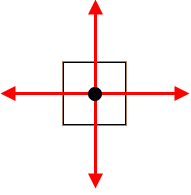Force diagrams like the one shown depict the direction and strength of forces by vector arrows. Longer arrows mean stronger forces. One can determine if the forces are balanced by looking at the arrow size. Equal length arrows mean that the forces are balanced. Such situations are consistent with constant speed.
Balanced vs. Unbalanced Forces - Questions 1 Help
There are four similar versions of this question. Two of the versions include:
Version 1:
The diagram below represents the forces acting upon a rightward-moving object. Each arrow represents a force; the length of the arrow represents the strength of the force.

Is this object speeding up, slowing down, or moving at a constant speed?
Is this object experiencing balanced forces or unbalanced forces?
Version 2:
The diagram below represents the forces acting upon a rightward-moving object. Each arrow represents a force; the length of the arrow represents the strength of the force.

Is this object speeding up, slowing down, or moving at a constant speed?
Is this object experiencing balanced forces or unbalanced forces?